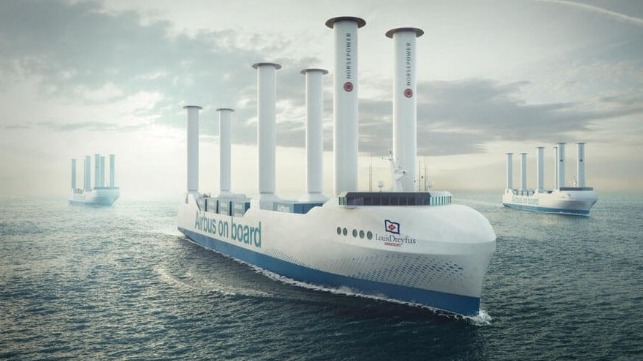Norsepower Receives Largest Wind Rotor Order to Deploy on Airbus Vessels

Continuing to make progress with the effort to launch three large, Ro-Ro cargo vessels using wind-assisted propulsion for Airbus, Finnish manufacturer Norsepower reports it has completed the largest order for rotor sails. The vessels, which will operate under charter for transporting airplane components, were ordered last month by Louis Dreyfus Armateurs (LDA) and will be built by China’s Wuchang Shipbuilding.
Norsepower confirmed that it has now finalized the order for what will be the largest installation of rotors, using a total of six rotors on each of the three vessels, supported by a new generation of technology. The design, which was previewed in October 2023, incorporates six 35-meter (115 feet) tall rotors placed in three pairs on each vessel along with two dual-fuel engines running on marine diesel and e-methanol. By 2030, while sailing on the transatlantic route, Norsepower reports that the Airbus fleet will generate approximately 50 percent fewer CO2 emissions compared to 2023.
“This fleet-wide deal is a game changer for the whole auxiliary wind propulsion industry,” said Tuomas Riski, CEO of Norsepower. “Firstly, it is the biggest deal ever made in the mechanical sails market, and in a world first, it includes our brand new Norsepower Sentient Control tool.”
A new patented control system for the rotors developed by Norsepower will help to provide better efficiency for the wind propulsion system and real-time saving reports. The system will permit each rotor to be controlled individually while also providing real-time force measurement, control, and saving reporting.
Norsepower explains the new system will optimize efficiency by managing the complex aerodynamic interactions between the sails and the hydrodynamic behavior of the vessel. The rotor sails use a small amount of electricity to rotate which harnesses the wind to produce the propulsive force which in turn reduces fuel consumption, emissions, and the cost of operation.

that matters most
Get the latest maritime news delivered to your inbox daily.
The full dimensions of the vessel have not been announced, but they have said that each will be able to carry around 70 40-foot containers and six aircraft subassembly sets expanding Airbus’ cargo capacity. They report that extensive Computational Fluid Dynamics (CFD) and wind tunnel tests have been carried out during the design phase to optimize the sail arrangement and design. They plan for the vessels to begin to enter service in 2026 and gradually phase out the company’s existing fleet. When e-methanol becomes available, they expect to further reduce emissions through the adoption of the alternative fuel.
The operations will also be supported by routing software that will optimize the vessels’ journey across the Atlantic. It will be programmed to maximize wind propulsion and avoid drag caused by adverse ocean conditions.
